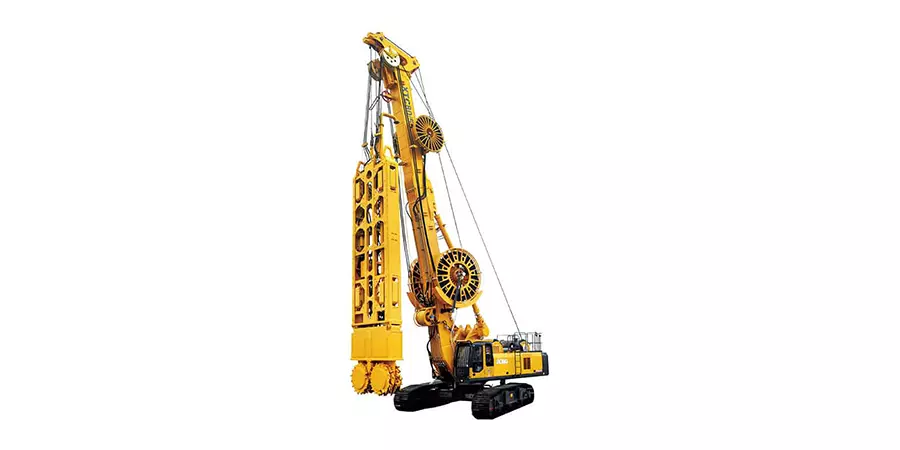Markets

Hydraulic Products Used in Double Wheel Trench Cutters
Double Wheel Trench Cutters (DWTCs) are specialized machines for constructing diaphragm walls and deep trenches. Their hydraulic systems must deliver high torque, precise control, and robust performance in harsh environments. Below is a detailed breakdown of key hydraulic components and their roles:
**1. Cutter Wheel Drive System
Hydraulic Motors
Closed-loop control with pressure feedback for adaptive torque adjustment.
Shock-resistant designs to handle abrupt load changes in hard strata.
Low-speed, high-torque radial piston motors (e.g., Bosch Rexroth MCR series): Torque up to 200,000 Nm, speed 0–30 RPM.
Redundant dual-motor setups: Ensure reliability during heavy-duty cutting.
Function: Power the rotation of dual cutter wheels to cut through soil, rock, or concrete.
Types:
Key Features:
**2. Lifting and Crowding System
Hydraulic Cylinders
Operating pressure: 35–42 MPa.
Cushioning systems to minimize vibration during start/stop.
Multi-stage telescopic cylinders: Compact design for deep trenching.
Synchronized cylinder groups: Maintain vertical alignment (±0.1° deviation).
Function: Control the vertical movement of the cutter wheels (stroke up to 40 meters).
Design:
Specifications:
**3. Slurry Circulation and Muck Handling
Hydraulic Slurry Pumps
Triplex plunger pumps (e.g., Gardner Denver): Flow rates 500–2,000 L/min, pressure 10–15 MPa.
Proportional flow valves: Adjust slurry flow dynamically based on soil conditions.
Function: Circulate bentonite slurry to stabilize trench walls and remove cuttings.
Components:
Durability: Ceramic-coated pistons and hardened valve seats for abrasion resistance.
Vibrating Screen and Hydrocyclone Drives
Function: Separate cuttings from slurry using hydraulic vibrators.
Technology: High-frequency hydraulic vibration motors (1,500–3,000 RPM).
**4. Travel and Positioning System
Crawler Drive Hydraulics
Axial piston motors (e.g., Danfoss H1): Torque 10,000–30,000 Nm for track movement.
Steering valves: Achieve tight turning radii (≤3 meters).
Function: Enable machine mobility and precise positioning on-site.
Components:
Leveling System
Function: Adjust machine stability on uneven terrain using hydraulic outriggers.
Control: Pressure sensors + proportional valves for real-time leveling (±5° compensation).
**5. Hydraulic Power Unit (HPU)
Main Pump Station
Variable displacement axial piston pumps (e.g., Kawasaki K3V): Pressure 35–42 MPa, flow 300–800 L/min.
Load-sensing (LS) technology: Reduces energy consumption by 20–30%.
Function: Centralized power source for all hydraulic systems.
Key Components:
Auxiliary Systems:
Oil coolers: Maintain oil temperature ≤60°C (air/water-cooled).
Filtration: Multi-stage filters (βₙ≥1,000 @ 10 µm) to combat contamination.
**6. Specialized Solutions for Challenging Conditions
Hard-Rock Cutting Enhancements
High-frequency hydraulic impactors: Superimpose vibrations (50–100 Hz) on cutter wheels to fracture rock.
Ultra-high-pressure water jets: 40–60 MPa jets to assist cutting and reduce wear on cutter teeth.
Sealing and Protection
Rotary union seals: Multi-layered PTFE seals to prevent slurry ingress.
Rod wipers and bellows: Protect cylinder rods from abrasive debris.
Key Brands and Maintenance Tips
| Component | Leading Brands | Maintenance Focus |
|---|---|---|
| Cutter Motors | Bosch Rexroth, Danfoss | Monitor oil temperature and seal wear. |
| Slurry Pumps | Gardner Denver, Weir | Replace ceramic liners every 500 hours. |
| HPU Pumps | Kawasaki, Parker | Check LS valve calibration quarterly. |
| Filters | Donaldson, Hydac | Replace at ΔP ≥0.5 bar. |
Emerging Technologies
Electro-Hydraulic Hybridization:
Electric servo valves for precise cutter positioning (±2 mm accuracy).
Predictive Maintenance:
IoT sensors track component health (e.g., pump wear, seal degradation).
Eco-Friendly Fluids:
Biodegradable hydraulic oils (ISO VG 46) for reduced environmental impact.
Why Hydraulics Dominate DWTCs
Power Density: Hydraulic systems deliver massive torque in compact packages.
Adaptability: Dynamic pressure/flow adjustments suit varying soil/rock conditions.
Durability: Components withstand abrasive slurry, high loads, and temperature extremes.
Summary
Double Wheel Trench Cutters rely on a sophisticated hydraulic ecosystem to achieve precision and power in demanding trenching applications. From cutter wheel drives to intelligent slurry management, each component is engineered for reliability. Innovations in digitalization and sustainability are shaping the next generation of DWTCs, enabling faster, cleaner, and more efficient underground construction.
